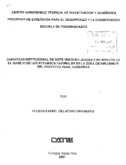Mostrar el registro sencillo del ítem
Capacidad institucional de siete municipalidades y su impacto en el manejo de los recursos naturales en la zona de influencia del Proyecto PAAR, Honduras
| dc.contributor.author | Villatoro Granados, N.R. | |
| dc.date.accessioned | 2020-12-15T15:17:53Z | |
| dc.date.available | 2020-12-15T15:17:53Z | |
| dc.date.issued | 2001 | |
| dc.identifier.uri | https://repositorio.catie.ac.cr/handle/11554/10142 | |
| dc.description | Tesis (Mag. Sc.)--CATIE, Turrialba (Costa Rica), 2001 | es_ES |
| dc.description | 202 p. | |
| dc.description | 36 ref. | |
| dc.description.abstract | El presente trabajo se realizó bajo la metodología de estudio de caso y tuvo como objetivo principal evaluar la capacidad institucional y organizacional de las municipalidades y su desempeño en el manejo de los recursos naturales locales. Se seleccionaron siete municipalides de las 24 que se encuentran en la zona de influencia del Proyecto de Administración de Areas Rurales (PAAR), bajo el criterio del nivel de desarrollo municipal alcanzado por cada una de ellas. Considerando la gran variabilidad que existe entre las categorías de municipalidades seleccionadas, se esperó que esa variabilidad se manifestara en términos de mejores características organizacionales. Sin embargo, los resultados indican que la diferencia en el desarrollo alcanzado se debe más a un amplia disponibilidad de recursos que a una capacidad de gestión y captación de los mismos. Ninguna de las municipalidades cuenta con una historia de planificación estratégica. Tres municipalidades tienen planes de desarrollo municipal, pero en ellos no se incluyen los recursos naturales como uno de los ejes para su desarrollo. Los planes de manejo de recursos naturales que existen son elaborados por organizaciones ajenas al municipio. Las munipalidades, con respecto a variables organizacionales como misión, visión, desarrollo de personal, manejo de procesos organizacionales, no muestran mayor diferencia pues en todas se carece de ellas. En cuanto al uso y manejo de recursos naturales y medio ambiente, cinco municipalidades cuentan con Unidades Municipales Ambientales, tres de ellas tienen planes de manejo forestal, pero solo una lo ejecuta en forma debida. Solo una municipalidad cuenta con un plan de manejo de cuencas. En los otros municipios, los planes de manejo los elaboran y ejecutan instituciones de desarrollo local. | es_ES |
| dc.description.abstract | The present work was carried out under the methodology of case study and it's main objective was to evaluate the institutional and organizational capacity of the municipalities and their performance in managing local natural resources. This pattern consists in evaluating the environment and the internal conditions of organization. Accordingly, seven municipalities were selected out of the 24 under the Rural Areas Administration Project (PAAR). Therefore, the municipalities were classified in four categories and two municipalities were selected from each category. Considering the different factors among the categories, it was expected that the results of this study were going to be expressed more in terms of better organizational characteristics. However, the results indicated that the difference between the developments reached by each municipality was more the result of the great variety of resources available, than to their capacity to manage them. None of the municipalities had historical data to support strategy planning. There municipalities had some type of plans for municipal development. However, these plans did not include the natural resources unless they were managed by an outside organization. With regard to organizational variables such as mission, vision, personnel development and managerial skills, there were not significant differences among them. As for use and management of natural resources and the environment, five municipalities had Environmental Municipal Units. Three of them had plans for forestal management. Furthermore, our case study indicated that only one municipality was carrying the plans as outlined. In addition, only one municipality was handling a plan for watershed management. In the rest of the municipalities, the plans were made and executed by developmental institutions at a local level. Three municipalities were managing the drinking water systems but with a different results among them. The territorial ordering was not included in the plans kept by any of the municipalities included in this study. | |
| dc.language.iso | es | es_ES |
| dc.publisher | CATIE, Turrialba (Costa Rica) | es_ES |
| dc.subject | DESCENTRALIZACION | |
| dc.subject | EVALUACION | |
| dc.subject | GESTION | |
| dc.subject | GOBIERNO LOCAL | |
| dc.subject | HONDURAS | |
| dc.subject | ORDENACION DE RECURSOS | |
| dc.subject | RECURSOS NATURALES | |
| dc.subject | DECENTRALIZATION | |
| dc.subject | EVALUATION | |
| dc.subject | LOCAL GOVERNMENT | |
| dc.subject | MANAGEMENT | |
| dc.subject | NATURAL RESOURCES | |
| dc.subject | RESOURCE MANAGEMENT | |
| dc.title | Capacidad institucional de siete municipalidades y su impacto en el manejo de los recursos naturales en la zona de influencia del Proyecto PAAR, Honduras | es_ES |
| dc.title.alternative | Institucional capacity of seven municipalities and their impact in the natural resources management in the area under the Proyecto PAAR, Honduras | es_ES |
| dc.type | Tesis | es_ES |
Ficheros en el ítem
Este ítem aparece en la(s) siguiente(s) colección(ones)
-
Tesis [2889]


